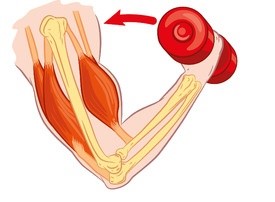Note that your final mark will not be saved in the system.
3.2.2.2 Levers Typeit
Type the correct answers into the spaces. Fill all the spaces before clicking ‘Check Answers!’

Levers exist in three classes, depending on the arrangement of the three fundamental components:
- – the resistance being moved, whether that is an external object or the weight of the body
- – the application of force by the user of the lever system, usually in the form of muscle contraction
- – the axis, usually represented by a joint or an anchor point
These can be used to amplify force or distance, depending on the type of lever used and the desired outcome of the sporting action. This is done using the mechanical advantage or overcoming the mechanical disadvantage of the lever, calculated using the ratio between the lengths of the effort and load arms. Let’s take a look at the different classes of lever below:
First-class levers are limited in the human body, with the most common example being that created in the neck when nodding the head. Another example can be seen using the anchor point of an oar when rowing. The rower gains a by increasing the distance between their oar grip (effort) and the oar lock (), i.e. the effort arm. This is achieved by a feature on rowing boats known as the rigger, which is an extension from the side of the rowing boat. If this feature was absent, the relative length of the (distance between oar lock and the blade in the water) to the effort arm would increase, creating a .
The placement of the fulcrum in second-class levers means that it creates a naturally long effort arm compared to load arm, and thus this lever class always operates at a . A prime example of a second-class lever is the ankle when jumping. The gastrocnemius and soleus muscles in the calf act as the , the weight of the body acts as the , and the is the metacarpophalangeal joint at the toes. This allows large loads to be moved with relatively little effort.
Third-class levers are always at a as the load arm is always longer than the effort arm. The performer must exert a greater amount of effort than the load acting in the opposite direction. The benefit is that range of movement is not limited as in first- and second-class levers, and actions can be performed with great speed. An example of this is the biceps curl, where the dumbbell in the hand acts as the which must be overcome by contraction of the biceps muscle as the . This action occurs around the fulcrum at the .